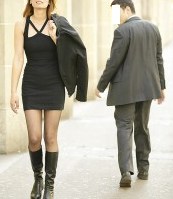the art and ethics of
CHECKING PEOPLE OUT

by
OLE MARTIN MOEN
_________________________________________________________
Ole
Martin Moen is a Research Fellow in Philosophy at University of
Oslo. Links to his research and publications are found at his
website www.olemartinmoen.com
You’re
walking down the street. Approaching in the opposite direction
you see a very attractive person. As he or she passes, you feel
tempted to turn your head so as to, well, check them out. I assume
that you have felt this temptation. I, at least, have felt it
many times. I have resisted turning my head, however, since doing
so is supposedly a bad thing.
But what,
exactly, is supposed to make it bad?
One answer
might be that it is a privacy invasion. But that can’t be
right. By turning your head, you don’t come to see anything
that isn’t already public. The perspective that you get
is identical to the perspective available to whoever is already
walking behind the person.
 A
slightly different answer might be that you ‘make use’
of another person without their consent. After all, when checking
somebody out, head-turners don’t ask for permission. But
this response is no more convincing. We don’t think that
looking at someone on the street for a few seconds requires their
consent.
A
slightly different answer might be that you ‘make use’
of another person without their consent. After all, when checking
somebody out, head-turners don’t ask for permission. But
this response is no more convincing. We don’t think that
looking at someone on the street for a few seconds requires their
consent.
A third
answer might be that, by turning your head to check someone out,
you objectify them: you treat them not as the full persons that
they are, but as bodily objects for your personal gratification.
And objectification, we are always told, is bad.
Much
has been written about objectification, but a few points are worth
making. First, it is a mundane -- but seldom emphasized -- fact
that human beings are, in fact, objects, and in that sense similar
to spoons, stars and satsumas. Admittedly, we humans belong to
a subcategory of objects that are also subjects, but that does
not contradict the reality that we really are objects (if you
are in doubt, locate a mirror). Accordingly, if we treat someone
as an object, we are not treating them as something that they
are not; we are treating them in accordance with just one of their
aspects.
Treating
someone on the basis of just one of their aspects can be bad.
It is certainly bad in cases where they are harmed as a result.
If I tread on your toe so as to reach for a book on a shelf, I
treat you merely as an object having no valid interest in not
being stepped on. I disregard your subjectivity and harm you as
a result. But is a selective focus on just one aspect of a person
problematic even in cases where it does not affect that person’s
well-being?
It might
be suggested that checking somebody out somehow reduces them to
one aspect (their physical attractiveness). But I don’t
understand what ‘reducing’ can mean in this context.
In one sense of the term, I am often ‘reduced’ to
one of my aspects. For example, I am counted -- I was counted
during registration at school, I am counted in the census. When
I am counted I am reduced to a quantity or a number. Sometimes
I am weighed. And sometimes I am registered as a citizen. But
does any of this reduce me in a problematic manner? Does it deny
that I have aspects other than a quantity, a weight, and a citizenship?
I don’t see why it should; it is only a selective focus
on one of my aspects for a purpose where the other aspects are
not so relevant. Equally, it is unclear why focusing on someone’s
body implies a rejection of the fact that the person has many
other aspects.
There
is, however, at least one plausible reason for why checking people
out on the street is wrong. By checking somebody out one might
make the other person annoyed, uncomfortable, and afraid. This
harm-based argument certainly counts against many forms of checking
people out.
Let me
therefore propose a rule: wait until the person is at least one
full step behind you before you turn your head. That way, they
are very unlikely to notice that you are looking, and as long
as they do not notice, they won’t feel uncomfortable, afraid,
or annoyed. (Of course, they might also turn their head to look
at you, and then notice you checking them out. But this could
result in a happy ending).
One worry
about my rule might be that others on the street could still see
what was going on. Yet why should that matter? If we grant that
the action itself is acceptable, it is puzzling that it could
be made unacceptable by a bystander observing it.
Granted,
there are many wrong ways to check people out. And it’s
not just that one’s behaviour might be annoying or threatening.
It might manifest a negative view of women (or men). When we are
providing an ethical assessment of an activity, however, the interesting
question is not whether there are bad ways of engaging in that
activity. For there are bad ways of engaging in virtually any
activity. The much more interesting question is whether there
are acceptable ways of doing it.
I contend
that there are no general reasons for why it is bad to turn one’s
head to check someone out on the street. Although there might
be good reasons to avoid doing so in many contexts (if it would
upset one’s fiancée, say), occasionally catching
a discreet glance over one’s shoulder can be morally just
fine.
Just
remember the one step-rule.